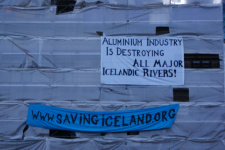Dec 02 2011
1 Comment
Wrong Climate for Damming Rivers
Google Earth Tour Reveals How a Global Dam Boom Could Worsen the Climate Crisis
International Rivers and Friends of the Earth International have teamed up to create a state-of-the-art Google Earth 3-D tour and video narrated by Nigerian activist Nnimmo Bassey, winner of the prestigious Right Livelihood Award. The production was launched on the first day of the COP 17 climate meeting in Durban. The video and tour allow viewers to explore why dams are not the right answer to climate change, by learning about topics such as reservoir emissions, dam safety, and adaptation while visiting real case studies in Africa, the Himalayas and the Amazon.

 Big dams have a serious record of social and environmental destruction, and there are many alternatives. So why are they still being built?
Big dams have a serious record of social and environmental destruction, and there are many alternatives. So why are they still being built?


 US rescue crews have airlifted some 170 people to safety from a remote village in the Grand Canyon after a dam burst following days of heavy rain.
US rescue crews have airlifted some 170 people to safety from a remote village in the Grand Canyon after a dam burst following days of heavy rain.


